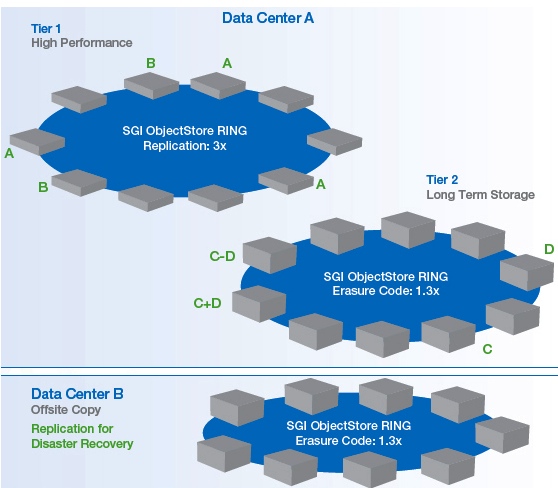SGI InfiniteData Cluster, ObjectStore and LiveArc AE for InfiniteStorage Gateway
With help of Cloudera, Hadoop and Scality
This is a Press Release edited by StorageNewsletter.com on October 30, 2013 at 2:37 pmSilicon Graphics International Corp. introduced InfiniteData Cluster, ObjectStore and LiveArc AE for InfiniteStorage Gateway as part of the company’s portfolio of big data solutions.
Focused on helping customers solve their most demanding business and technology challenges, the new solutions enable business and government agencies to perform big data analytics with faster and greater insight, achieve the capacity and scale needed for big storage, and manage storage investments more cost effectively.
“As businesses tackle the rising volume, velocity, and variety of big data, they face a growing challenge – how to unlock value at greater speed, scale and efficiency,” said Jorge Titinger, president and CEO, SGI. “SGI’s expertise in designing and building some of the world’s fastest supercomputers enables customers to fully optimize HPC for big data analytics to achieve business breakthroughs. As a Top 10 storage provider and with many years’ experience helping customers manage some of the world’s largest data environments cost efficiently, we are applying our expertise in big storage to deliver solutions increasingly needed in today’s enterprise.”
Optimized Hadoop Performance for Faster,
Greater Insight – Factory Integration to Lower Costs
Utilizing Xeon processors E5-2600 v2 and up to 12 4TB drives per tray, InfiniteData Cluster delivers a 1:1 core to storage spindle ratio to optimize Apache Hadoop software, and coupled with high speed interconnects, provides up to 40 nodes and 1.9PB in a single rack – twice or more the compute and storage density per footprint of all other HPC solutions for big data analytics. Factory-integrated with the Cloudera Hadoop distribution running on Red Hat Linux software and SGI Management Center, InfiniteData Cluster solutions arrive pre-racked, pre-configured, and pre-tested, saving 100s to 1,000s of IT man hours and providing business with a world-class analytics platform in days versus months.
“Today enterprise organizations need big data analytics solutions that are not just indiscriminant storage vaults, but are also innovative repositories of insightful data,” said Tim Stevens, VP, business and corporate development, Cloudera, Inc. “Cloudera’s platform for big data, with Hadoop at its core, is a comprehensive data management platform. Combined with the SGI InfiniteData Cluster, joint customers gain a considerable competitive advantage as they address their big data challenges to gain value from all their data.”
The InfiniteData Cluster platform architecture offers flexibility and scalability to address a range of customer needs, with choice of drives, network connectivity and more processor cores. SGI Management Center provides automated, policy-driven power management. And to reduce energy consumption, all components are serviced from the front of the rack to support hot aisle/cold aisle floor plans.
SGI’s new InfiniteData Cluster is part of a suite of HPC solutions for big data analytics addressing two principle metrics – data analysis and time to value. If data relationships are sufficiently understood to allow parsing into chunks using Hadoop, and the need for results allows hours to days, InfiniteData Cluster is a solution. If parsing warrants the use of a NoSQL database to provide organizational structure or if value can be gained from results measured in minutes, SGI DataRaptor with MarkLogic Database is optimal. And for business environments looking for hidden data relationships using graph analytics or wanting to perform analysis in real-time, SGI UV system is a powerful shared memory platform.
SGI ‘Sandbox’ for Hadoop
The unfamiliarity of Hadoop solutions for lines of business and IT often warrants a ‘proof of concept’ to first understand the capabilities of HPC and Hadoop for big data analytics. This often, however, adds several months before realizing big data initiatives, as well as expense. To accelerate business assessment and allow IT to gain benefit, SGI is making an InfiniteData Cluster available online, pre-configured with RedHat Enterprise Linux and Cloudera Hadoop, for customers to upload their own data and explore big data analytics. SGI’s Hadoop Sandbox is targeted for availability at year end.
Extreme, Object-based Storage Capacity
New ObjectStore delivers storage capacity and cloud scalability for big data. Integrating SGI’s OEM of Scality RING software with its Modular InfiniteStorage Server hardware, ObjectStore provides a proven, object-based, “scale-out” storage solution for petabyte environments.
The RING peer-to-peer architecture allows SGI’s storage environment to overcome the strain massive data volumes place on conventional storage file systems. The ObjectStore system architecture delivers a shared storage pool supporting thousands to millions of users, with limitless file size and quantity, and performance rivaling block-based storage. Nodes can be added at any time to increase capacity – without interrupting users or performance levels. Erasure code technology reduces risk of data loss in the event of node or drive failure to effectively zero. And the environment self-heals with no RAID rebuilds, raising service levels. Delivering up to 2.8PB per rack, ObjectStore solution can also save enterprise environments 40% or more in capital and operating expenses, even in comparison to public cloud storage.
Intelligent Management of Active Archives
Coming to InfiniteStorage Gateway, the integrated, active archive solution enabling enterprises to lower the cost of high volume storage, SGI is introducing LiveArc AE, a special ‘appliance edition’ of LiveArc software to be embedded in the gateway before year end. Delivering intelligent management for active archives, LiveArc AE provides fast search, facilitates compliance, and helps achieve DR. As infrequently accessed data is moved to the InfiniteStorage Gateway, LiveArc AE automatically indexes metadata and file content, enabling a variety of valuable capabilities. Users can quickly search across the archive using free-text queries to locate needed files. Version history can be captured with audit trails. WORM functionality can be implemented such as restricting file deletion or changes. Data retention periods can be set. And remote replication of archived data can be automated based on policies, with inline encryption for security and file level de-duplication to reduce storage consumption.














 Subscribe to our free daily newsletter
Subscribe to our free daily newsletter

